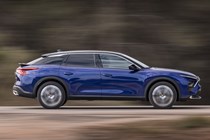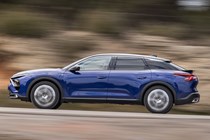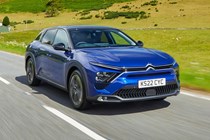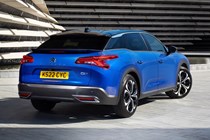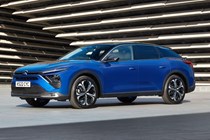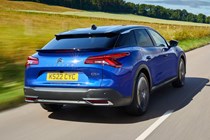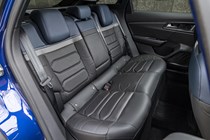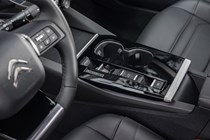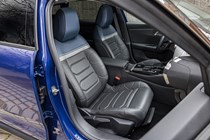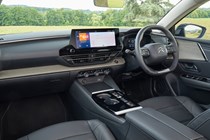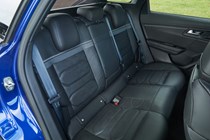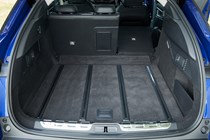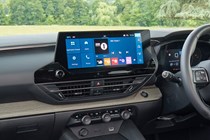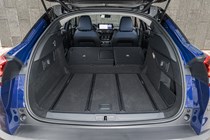
Citroën C5 X long-term test
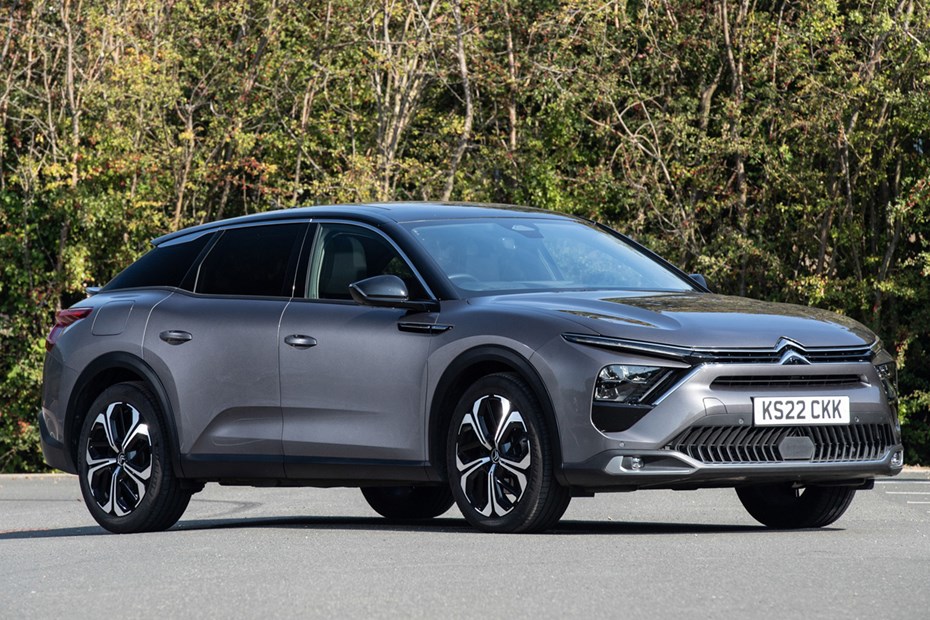
If it’s one thing the French car industry is (historically) known for, it’s squashy family cars. But there has been a conspicuous absence of marshmallow-sprung hatchbacks making their way across The Channel lately. Does the Citroen C5 X herald the return of this trend-bucking concept? Adam Binnie (aided by Murray Scullion) puts the Parkers Large Family Car of the Year through its paces.
Report 1: Welcome
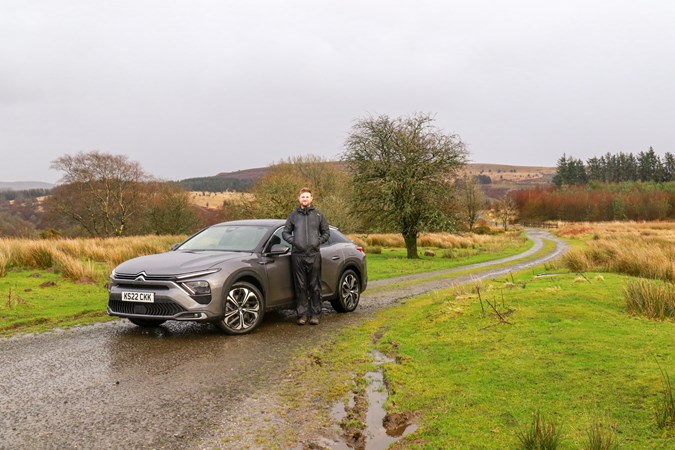
We say bonjour to our Large Family Car of the Year – but what on earth is it – an estate, an SUV, or a coupe? Or sort of all three?
Last year all the editorial staff of this website sat down around a large meeting table to have an argument. Admittedly this is a regular occurrence, but this specific example was about our Car of the Year awards.
I won’t bore you with the kinds of tattle we rattled off (mostly disagreeing about what constitutes a small or large car) but I will reveal at the end of it we did actually decide on our Car of the Year. Spoiler alert – it wasn’t the C5 X.
We however grant it a class win – as the best large family car on the market. We loved its comfy seats and big boot – all of which are great for a family.
I’ve written about this somewhere before but I’ve fallen out of love a bit with cars that claim to do it all. They’re never as fun to drive as riding my motorbike and never as practical as a van. And in the pursuit of both you end up with a vehicle that is uncomfortable riding as it is compromised on interior space.
Which C5 X do we have here?
This car promises to be something a bit different though, seemingly not at all concerned with athletic ability, it’s been granted the kind of suspension springs you’d expect to find in a spa hotel mattress (they’re really soft, basically).
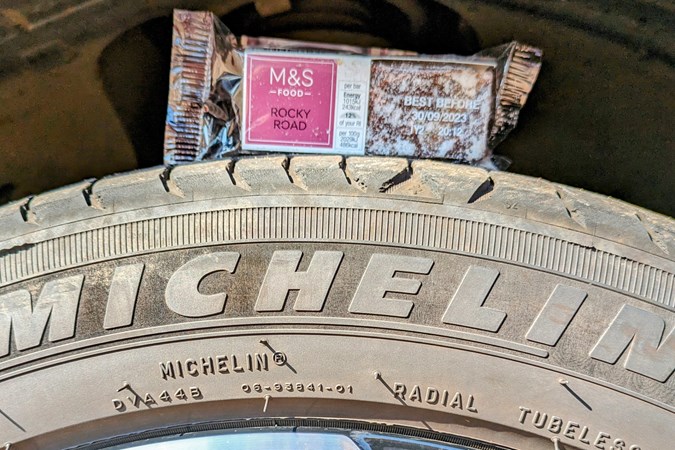
It’s also the most expensive combination of spec and engine – full-fat Shine Plus spec with plug-in hybrid (PHEV) power. At time of writing, our car, including options, comes in at £42,790. Which on the surface is punchy for a Citroen.
Shine Plus means you get all the goodies. I won’t list them for fear of being dull, but the highlights include a head-up display and Citroen’s Advanced Comfort suspension with progressive hydraulic cushions, which means loads of squishiness.
Do a little digging though and it becomes apparent that there’s some good value for money going on here. The PHEV is officially capable of driving for up to 38.5 miles on electric power and 236.2mpg. These figures are nonsense and I’ll explain why a bit later on. But nevertheless, PHEVs offer a ‘have your cake and eat it’ moment on paper.
Cost options include the paint (£650), two tone seats with ventilation (£800), panoramic roof (£1,300) and black roof (£350).
First impressions
It is indeed extraordinarily squishy. One of the squishiest cars on the road. On the motorway especially I was quite surprised by how floaty it was. I’ve done a few hour and a half commutes now and they have been a treat.
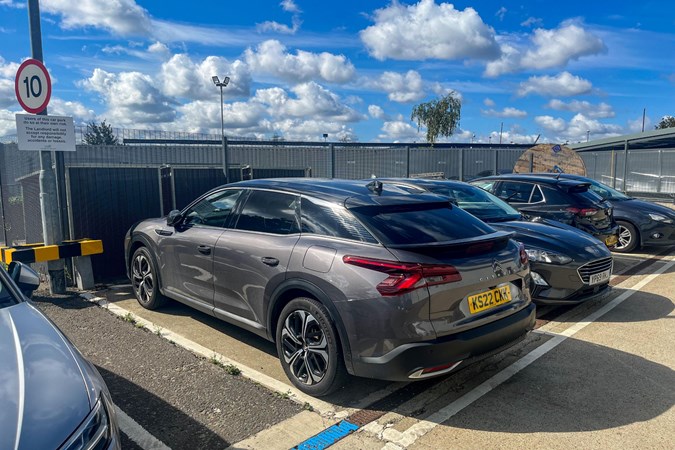
However I have noticed that if you hit a particularly large bit of rough road at speed you can almost feel a bit seasick. It’s not like huge vibrations come through the seat and there’s no thud, but there seems to be a large delay in your eyes seeing the tarmac and actually feeling the change in the suspension.
This is also probably a good juncture to point out my petrol-headed kids have never been sick in a super car, only ever in softy-sprung models. So we shall have to see whether this Citroen is sleep or vomit inducing.
Incidentally for those of you who have read my last two long termer pages, my children have named this one too (previously bestowing VW Transporter Kombi Gary and the Caddy Life Dexter). Any guesses for the Citroen? No, you won’t get it – Clementine. Because it’s a citrus fruit and sounds vaguely French, apparently.
I don’t know where they get it from.
Report 2: Spec check
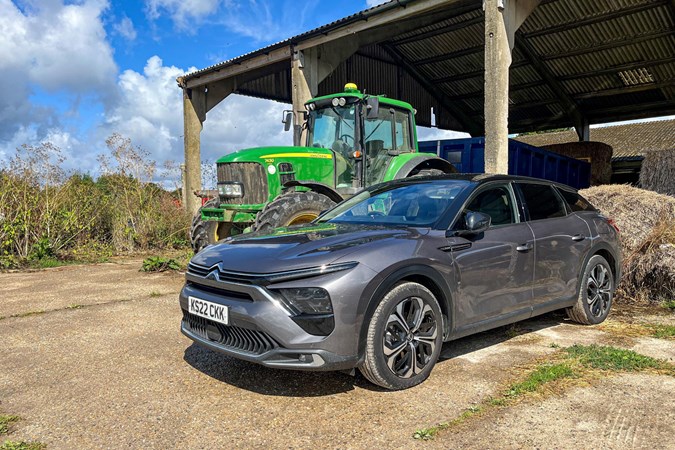
A deep dive into the C5 X version we’re running for the next six months – what engine does it have, what specification is it, at what options have we got?
Let’s talk specification now so we’ve covered it – the Citroen C5 X I’m running is a Shine Plus with the 225hp plug-in hybrid engine and eight-speed automatic transmission.
I’ll cover off the drivetrain in a separate update and for now will concentrate on what bits and bobs you get with this top-tier trim level.
Or at least it was – I can’t see it on the Citroen website now, as it appears to have been replaced by the Hypnos model, but for all intents and purposes you get the same standard kit.
From new this car cost £39,960 (rising to £42,790 with optional extras I’ll cover in a bit) and comes with all sorts of niceties like heated and ventilated massaging front seats and radar cruise control.
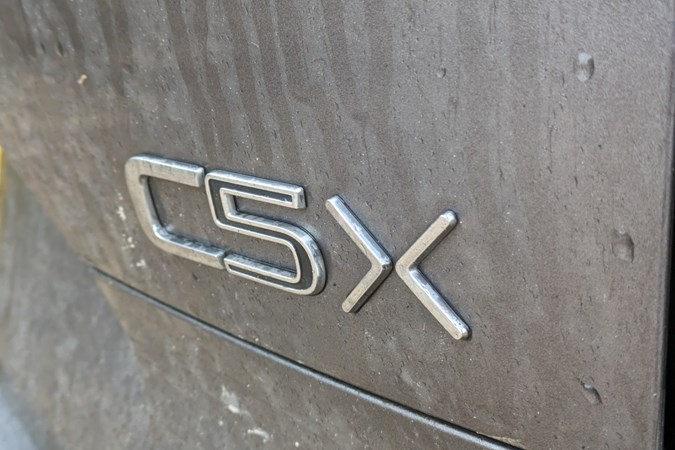
There’s actually a fair bit of driver assistance tech onboard, with things like automatic braking that can pick up pedestrians and cyclists even at night, lane keep assist, traffic sign recognition and blind spot warning.
The suite of cameras covers the whole 360 degrees outside the car – you can select from the front, rear and side views separately and also see a top-down display, which is particularly helpful in narrow drive-through lanes (apparently). There’s a button to press to wash the rear camera, as it gets quite dirty in bad weather, but you’ll have to do the front one by hand.
Passive safety kit includes airbags in the front, plus lateral and curtain units, Isofix points in the outer rear seats and the spec sheet also lists electronic rear child locks, but my car seems to have the standard ones you have to manually activate and deactivate by turning a toggle with the key.
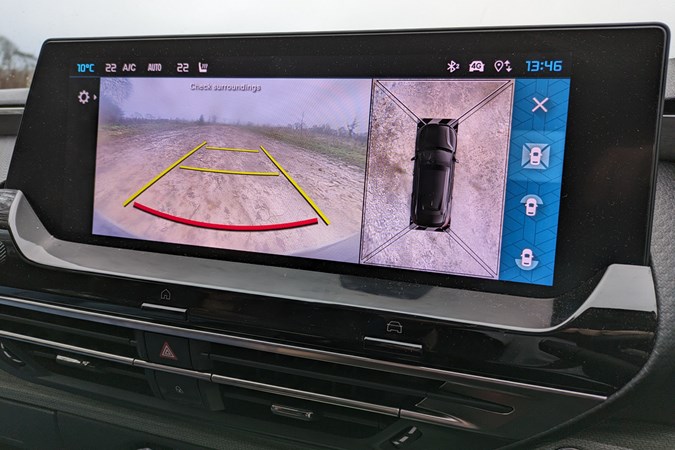
All of this plus the extremely stable handling makes the C5X feel like it’s really got your back. I’ve found the lane assist a little sensitive on the motorway but that’s not particularly unusual, and it’s much better if you let it do its thing rather than fighting it all the time.
I’ve had a couple of moments where the crash prevention system has jammed the brakes on unnecessarily, when cars have pulled out at roundabouts and I’ve already been slowing to avoid them, but otherwise the driver assistance systems are more useful than not.
Outside the car you get automatic LED headlamps high beams that come on and off by themselves – these are good and bright even on a dark country lane and seem to react quickly when they spot an oncoming car, dropping back to normal headlights before dazzling the driver.
This model comes with the (optional) top spec interior with two-tone leather, Advanced Comfort seats in the front. These are big armchairs the like of which you don’t often find in cars these days and are just as squashy and supportive on a short trip as a long one. Electronic adjustment with memory setting makes it super easy to get into the right driving position every time too.
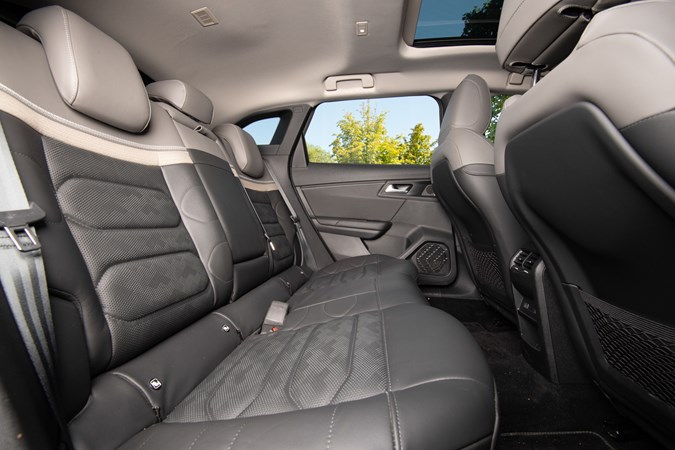
The dashboard and door cards feature satin chrome trim and wood effect panels, which in combination with the lighter section of leather on the seats, makes the interior feel more spacious and airy. The huge (optional) panoramic glass roof helps too, and this has a manual cover that you can slide into place on bright days.
Getting the perfect ambiance is easy thanks to dual zone air con than you can adjust with physical controls (or on the touchscreen, which we’ll get to later), which is an unusual thing these days. There is a bit of lag between rotating the dial and anything actually changing on the screen though.
Helping to keep things quiet is acoustic glass in the screen, as well as the front and rear windows. This block out the majority of the wind noise you’d normally hear on a long drive and means the cabin is spookily hushed even at motorway speed. The back window is heated but there’s no wiper blade – I’m several months of ownership in now and this still catches me out.
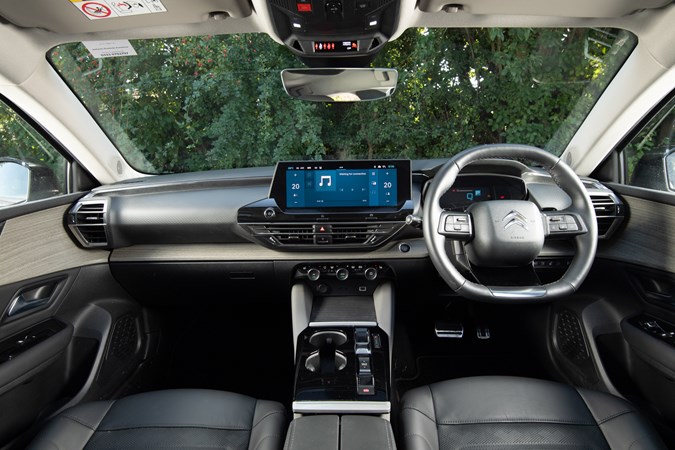
The doors unlock and lock themselves when you walk to and from the car but I’ve found this a bit hit and miss – the car quite often unlocks when I don’t want it to as I walk past it in the morning but then fails to when I’m coming back to it in a car park, meaning I have to use the button on the key. It does always seem to lock though, and announces this to the world with a loud beep that I can’t work out how to disable.
This model has a 7.0-inch digital display that can be customised with different information, supplemented with a head up display projected onto the windscreen, plus the larger 12-inch central touchscreen (an upgrade over the standard 10-inch) with functions clustered together in easy-to-use tiles. It’s a really intuitive system and responds quicky to prods and swipes.
Apparently specific to the plug-in hybrid model is Citroen’s Advanced Comfort Active suspension with Progressive Hydraulic Cushions – we’ll cover this off in the driving update but even from the first trip I can confirm this is very effective.

Other options fitted here include the Platinum Grey metallic paint and black bi-tone roof. Citroen also offers a £500 “hi-fi upgrade” which is a bit vague, especially as premium rivals will offer a branded stereo, and the standard system is already pretty good.
Longitudinal roof bars are a £200 option and I’m a bit conflicted about this – if you want them (and I do) that’s not a huge cost, but it’s more a question of whether they should be included already. The C5X is a mix of estate and SUV (says Citroen), both of which should come with roof rails already, if you ask me.
But it’s also apparently a coupe, and I suspect this is the reason they’re absent (along with the not-available rear wiper blade), which might make sense in a designer’s sketchpad, but in the real world if you’re buying something of this size and ruggedness, there’s a pretty good chance you’ll want to put something on the roof. Why not make removing the rails a no-cost option instead?
Report 3: Comfort
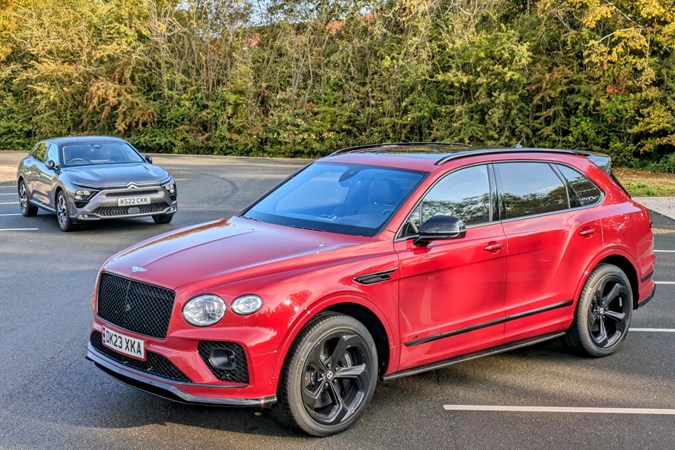
A slightly niche twin-test, this one, but since I had the keys to Bentley Bentayga after a photoshoot I thought it might be a good idea to see how it stacks up against the Citroen C5 X.
Why? Well it won’t be the first time Citroen has been mentioned in the same sentence as an ultra-exclusive British luxury car marque – various Rolls Royce models have ridden on hydropneumatic suspension licenced from Citroen, after all.
In fact the French maker is intrinsically linked with a very typical ride quality, a way of ironing out roads plagued with potholes and their repairs, speedbumps and raised ironworks, so that the occupants of the car feel like they’re gliding across a river of whipped cream.
You’d imagine that would make Citroen’s cars very popular in the UK. Thing is though, that special hydropneumatic suspension set up hasn’t been used for a while now, and even then only on very limited models. The fabled Magic Carpet ride has become something Citroens used to be known for.
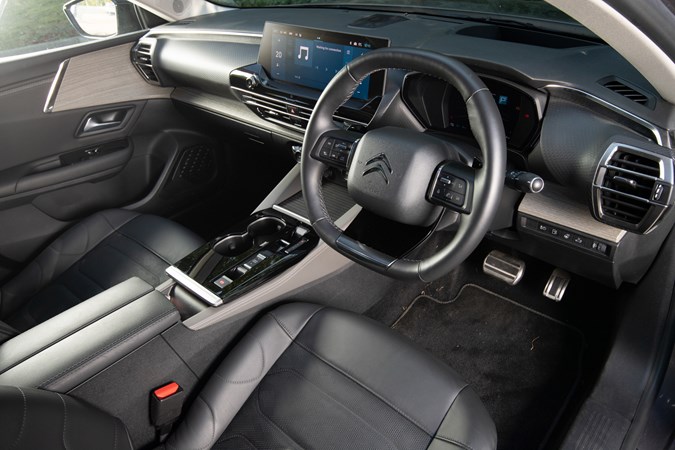
That’s partly down to the fact it’s quite expensive to fix when it goes wrong, and also because (arguably) better and more reliable technology has come along to replace it. The main issue is that softly suspended cars also have a bit of an image problem – travelling slowly and in comfort seems at odds with the 21st century need to get everywhere and do everything faster.
In the C5 X Citroen’s Advanced Comfort Active suspension uses a camera to scan the road and a sensor in each wheel so it can adapt to the road surface beneath it, while special Progressive Hydraulic Cushions take the crash and bang out of big compressions – when you roll into a pothole or over a speed bump for example.
I’ll leave the tech-talk there for now because what really matters is how it performs and how it differs from the £200,000 Bentayga, which delivers a respectable waft, but also corners like it’s on rails. When you hit a bump in the Bentley it gets soaked up and the suspension uncoils quickly before it has to deal with the next one. When you go around a corner the body stays level, even if you go quite faster, and so next time you go even faster. This type of driving becomes a habit unless you have very good self-control.
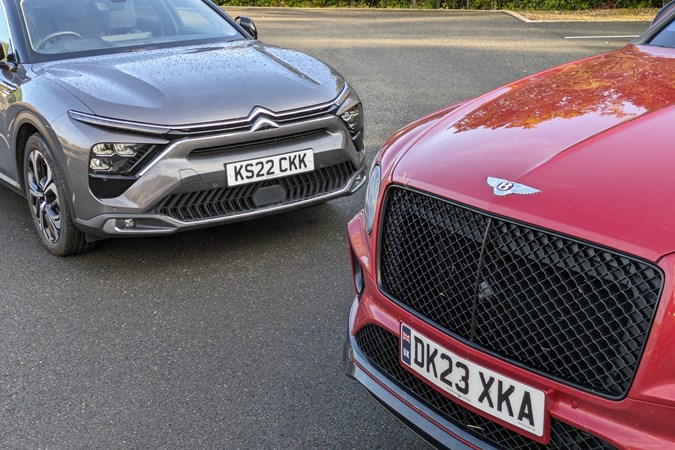
In the C5 X things are a bit different. I don’t want to describe it as floaty because that has all sort of vomitus connotations, but the body certainly moves around a lot more. When you hit that same bump, the shock is cushioned and the suspension rebounds slower, so even at low speed the car feels very comfortable indeed.
Where before I used to get great pleasure driving a well-set up car around a corner, now I get the same satisfaction from arriving at my destination with my average heart rate matching a sleeping cross-country skier.
What’s nice is that the body stays surprisingly composed even when you start to drive more quickly. I won’t call it sporty, but also because that kind of misses the point. It’s good enough so that it feels in control at all times during normal driving, but not so good that you feel like you’re wasting the car’s ability by not exploiting it.
But even so, you’d expect all sorts of diving under braking and rolling around in corners with a ride as soft as this, and while there is a bit of that, it’s nowhere near as prominent as I thought it would be, which is quite remarkable really. I’ve driven comfier cars but they had a Rolls Royce badge and a price tag larger than a house.
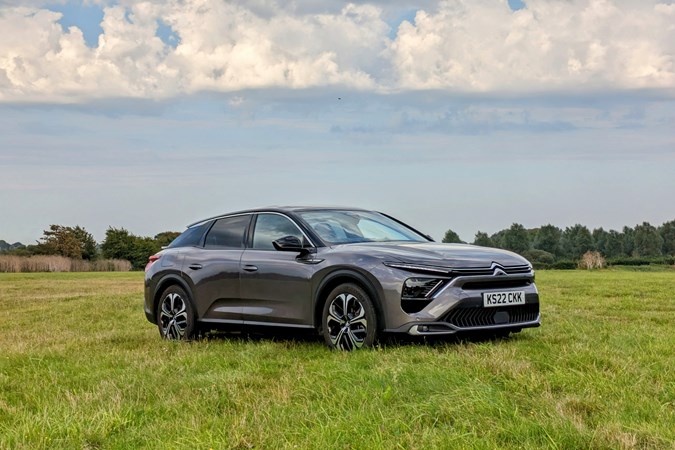
As a case in point (and excuse to talk about the legendary Citroen 2CV and its ability to safely carry a basket of eggs across a ploughed field) I took advantage of access to a grassy car park earlier in the year, and drove really quite quickly across it, without anyone inside the car complaining.
It’s also worth talking about the more passive comfort measures in the C5 X – the seats are big and squashy but also supportive so you don’t get back ache. And if you do they have a massive function. The leather is soft and the cabin filled with warm, wooden trim and the controls click into place smoothly – even the air conditioning is really quiet.
It seems like Citroen has captured all the good stuff about driving a comfortable car and then worked on removing all the negatives, like wallowy handling and a boring image.
The plug-in hybrid drivetrain also plays a role here, but we’ll cover than in a future update. For now just know that if you want something cossetting and relaxing, I really can’t think of anything better than the C5 X short of a Bentley.
Report 4: Practicality
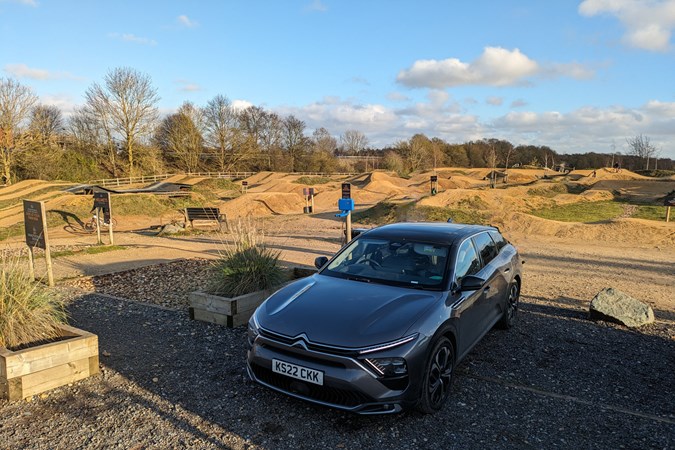
How big is the boot, how many bikes can you fit in it, and what are the rear seats like for passengers? All this questions and more answered with a day out at the bike park
Unsurprisingly this update is going to feature a lot of pictures of the C5 X with bikes and other stuff in the boot – this is a large car with a sort-of estate body shape after all, so we’re going to need to see how it functions when loaded up.
Let’s kick things off with some measurements and comparisons to start with though. The C5 X has 485 litres of seats-up boot capacity, increasing to 1,580 litres when you fold them flat.
Compared with the perennial boot master in this segment, the Skoda Octavia Estate, the Citroen is pretty much on par (490/1,555 litres for the PHEV variant), and in fact has more space with the seats folded.
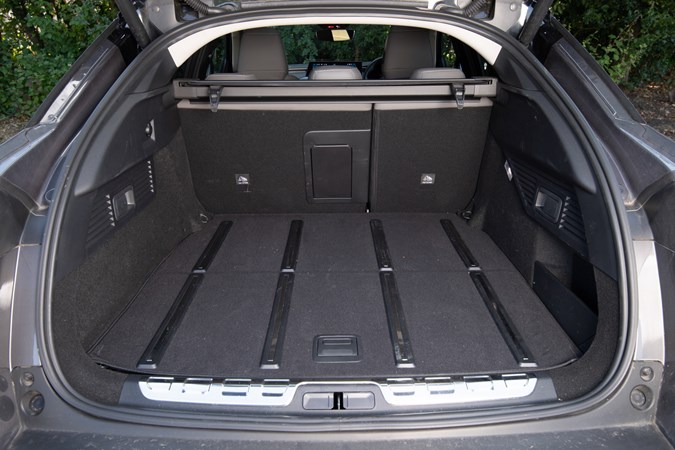
The C5 X is a bit bigger externally than an Octavia though, with an additional 10cm of length, but not as long as the larger Superb Estate. At 2,062mm wide (including mirrors) it is wider than both cars, and does feel pretty large on the road as a result.
Although usefully square, the boot does lose volume in the plug-in hybrid model. Conventionally powered cars have 545/1,640 litres of space, still lagging behind a VW Passat Estate but decent enough, so pick the petrol car if outright capacity is important to you.
The floor comes complete with four longitudinal metal strips that aid sliding things in and out, plus levers in the boot itself for collapsing the rear seats, which is always a handy function.

Here you can see it loaded up with a regular weekly food shop for two adults and two children. I reckon we could get another couple of full bags in there without drama, so it’s a pass in my book.
There isn’t much of a boot lip to haul things over (in fact the outside of the car is lower than the boot floor) but the bumper does stick out rather a long way, so it can be a stretch to get things right into the far corners if you are short.
A horizontal metal trim piece protects the edge of the boot and makes it easier to slide things in and out, which is useful, but I am a bit worried about scuffing it with sharp edges, the kind you find on a mountain bike pedal, for example.
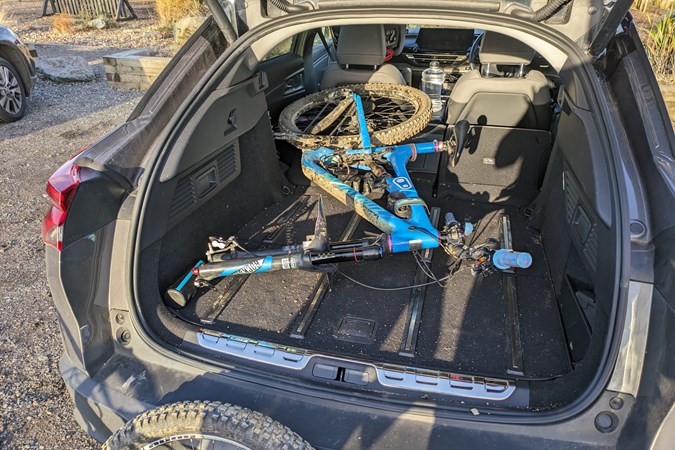
Here is the C5 X with a large 27.5-inch wheeled MTB in the boot and as you can see, you have to remove the front wheel and drop one of the seats to get it to fit, which isn’t particularly unusual in fairness.
The rear seats don’t fold properly flat so you’re left with a bit of a ramp, but there is a tie-down hook in each corner to help secure things.
I’ve also found the small cubby on the right hand side the perfect size for storing my small torque wrench and hex bits, but there are no hooks high up for hanging a helmet from, sadly.
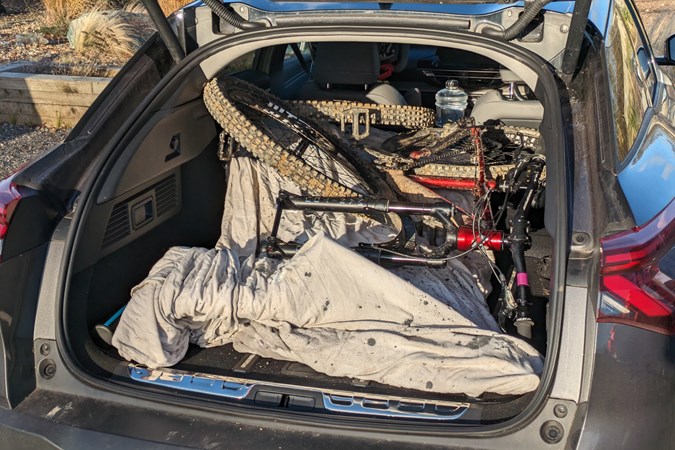
I managed to get my son’s 24-inch wheeled mountain bike in there on top of mine (after adequately protecting it, of course) so it is possible to go out together, but only if you fold the other rear seat down. So no one else could come with us.
At this point the £200 roof rails start to look like a no-brainer, or one of the kits you can buy from Thule or similar.
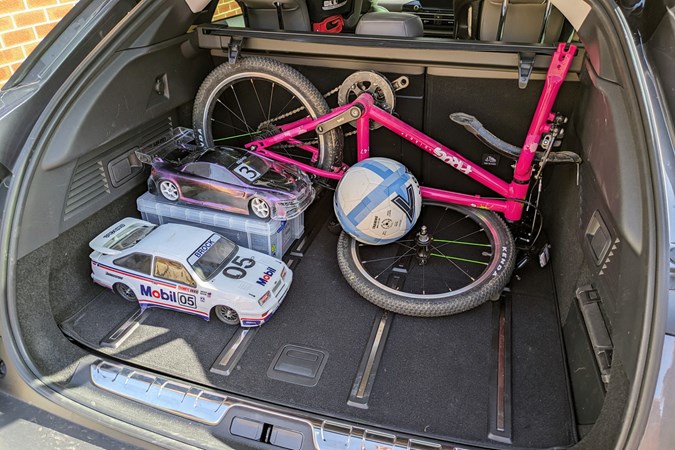
Thankfully there is more than enough room for our standard Saturday morning activities of driving RC cars and playing football while my daughter rides her 18-inch bike at high speed.
Again only if you take the front wheel off the latter (although it does go in diagonally fully assembled, and takes up the whole boot).
Moving into the rear of the car, we’ve said in our full review how the C5 X’s coupe roofline means there isn’t much headroom for adults, but it’s absolutely fine for my kids.
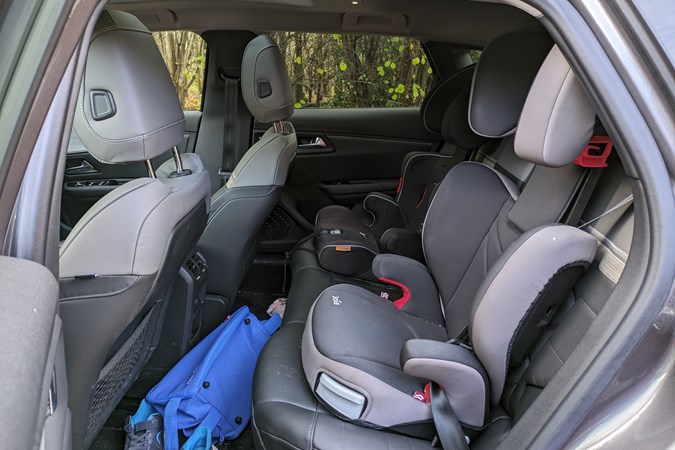
They’re on the verge of not needing booster seats anymore and the high seat point/low roof results in a bit of a manoeuvre to get their chairs in and out, but they have plenty of legroom when they’re in.
Rear passengers get a bottle pocket in the door, a stretchy net magazine holder on the back of the front seats, and their own air vents pointing out of the front centre console. The widows are reasonably high up but large to let enough light in, plus there are smaller quarterlights behind.
Altogether the C5 X offers reasonable practicality for its size – I think if you regularly transported adults or taller kids in the back it might start to feel a bit cramped, but for us it’s pretty much spot on.
Report 5: Driving
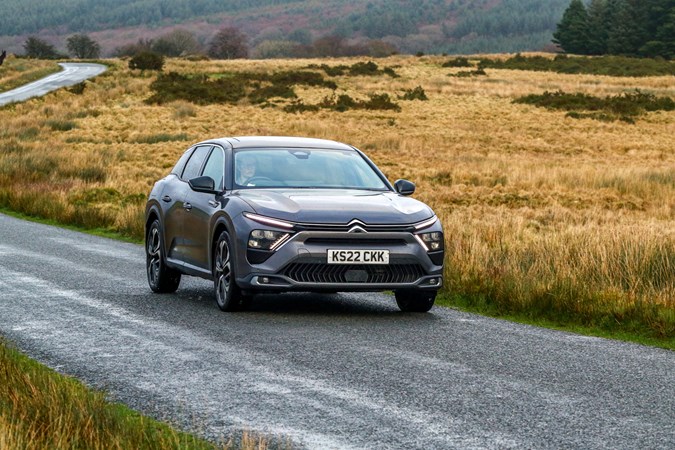
Can a comfortably sprung car excite as well as cosset? Does it even need to? And how does the PHEV powertrain stack up against the standard petrol?
There are two versions of the Citroen C5 X to choose from and they both offer very different things, so it’s a good idea to work out exactly which is right for you and then make sure you get a decent test drive.
The entry level powertrain is a 1.2-litre petrol with 130hp, which means leisurely progress. The plug-in hybrid version here has 225hp and is suitably brisk as a result – providing you keep it charged up. Both are front wheel drive only despite the off-roader looks.
Why pick the smaller petrol? Well, it comes with a usefully larger boot as described in the previous update, and also weighs 300kg less, which our road testers said had a noticeable affect on the handling.
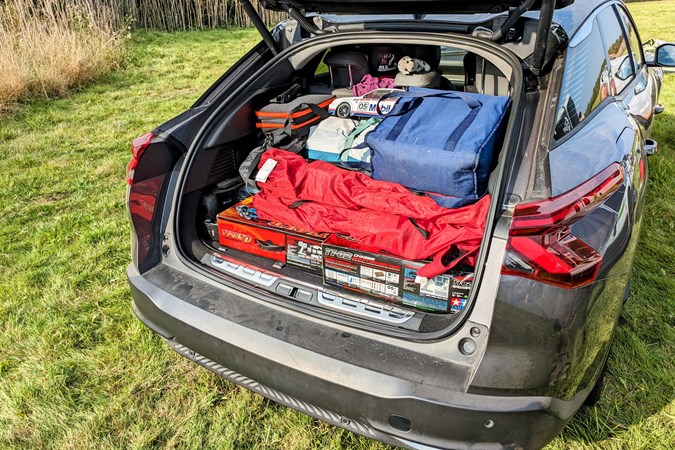
However, they (and me) also pointed out that the PHEV is the one to go for if you want the ultimate in C5 X refinement – again, only if you keep the battery charged up.
This has a 12.4kWh capacity and takes less than two hours to fill from empty if you’ve got a 7.4kW wallbox at home. In pure EV mode I’ve seen anything from 16 to 26 miles promised, depending on the temperature outside, but bear in mind I’ve only really used it in cold months. The fuel economy display has stuck resolutely above 60mpg in the time I’ve been running it.
Like I say though, I charge the battery at the start and end of every journey, so I’d expect to see that drop if that wasn’t possible. It’s also much nicer to drive when the battery is full – the 1.6-litre petrol engine can be a bit noisy when it’s the sole supply of propulsion, whereas in hybrid mode it’s admirably quiet.
The electric motor also does a great job of filling in the gaps in power delivery and is complimented by a super-smooth eight speed automatic gearbox. I’ve got on really well with the C5 X, it always seems to give you the acceleration you need without hesitation, or noticeable shunts from changing gear or switching from electric to petrol power. There are shift paddles behind the wheel but tellingly I’ve never felt the need to use them.
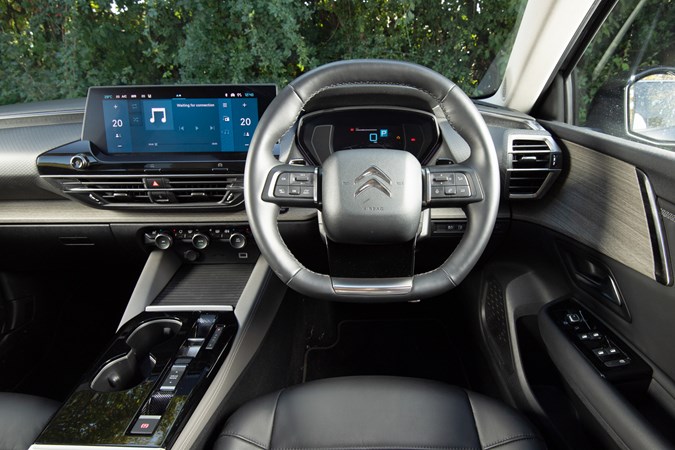
Equally I’ve spend most of my time in the “Hybrid” driving mode, having tested “Comfort” a few times, but found its preference for petrol power ruined my fuel economy. Sport mode sharpens things up but I’ve not really felt the need.
Joining faster roads is no stress thanks to a 0-62mph time of 7.9 seconds – a capability I find I rarely use, because the C5 X whisks along so nicely, I don’t feel the need to press the gas harder and stretch the petrol engine.
I’ve touched upon the handling already and it’s definitely set up for comfort rather than lap times. Previously I’ve found softly suspended cars less comfortable overall because they roll so much and make everyone slosh around inside. You have to think about how you approach every corner to ensure you get around it comfortably and this ends up being more stressful and tiring than a stiffer set up.
The Citroen somehow manages to keep this largely in check unless you’re really pushing on, which means you can just drive it normally. It has pretty sophisticated suspension though, with a camera than scans the road for imperfections and sensors in the wheels to set up each corner individually. The Progressive Hydraulic Cushions come into play when you hit something square-edged like a pothole, avoiding that harsh bottoming-out sensation.
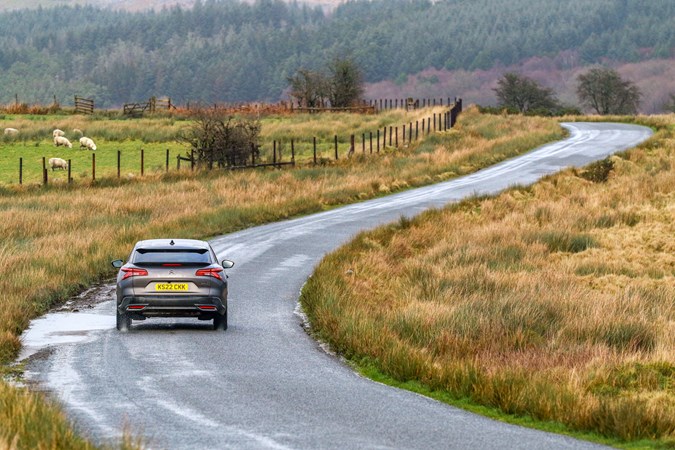
That’s particularly impressive when you consider the kerb weight (1,826kg) and the large 19-inch wheels. If we were playing fantasy drivetrain though I think a big, unstressed diesel engine would be absolutely magic in the C5 X. An old six-cylinder one ideally. Then you’d get all the smoothness and torque of the PHEV but with less weight and a bigger boot. Those days are probably gone though.
That does raise another point though about range – while most of my journeys have been well within the C5 X’s battery range, we have undertaken some longer drives on days out or to see friends and family, at which point the fuel range on the dashboard suggests anything from 200-250 miles to a full tank.
This suggests the fuel economy on the motorway is somewhat less than the 60mpg average the car claims, and we’ll be able to investigate that further in the next update when I’ve calculated the mpg between fill ups.
Update 6: Farewell

It’s time to wave goodbye to the C5 X, but where will it fit in the great pantheon of Parkers long termers?
We’ve reached the end of the road for the Citroen C5 X and I’m genuinely sad to see it go. It’s been a soothing and relaxing way to transport my family around for the past six months, and 4,600-odd miles.
Initially I was a bit concerned about transferring back into a car – my last two long termers were vans, a VW Transporter and then a Caddy Life – and I’d become fully converted to the abundance of space for transporting bikes and bootfuls of associated accessories.
I briefly considered getting a set of roof bars to solve the problem but given the time of year I’d be custodian of the C5 X (November is non-stop at work and then it’s too cold and muddy to ride regularly) it didn’t seem like a worthwhile investment.
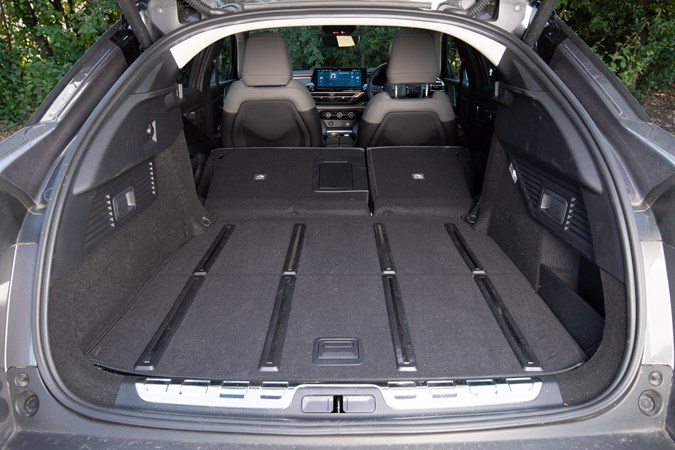
If I owned the car or was running it in the warmer months I’d definitely have specced the £200 optional roof rails or bought some aftermarket ones. You can see in my practicality update that we managed to get out on our bikes a few times but it’s a bit of a faff putting them in the car, and an even bigger faff cleaning the mud from the interior afterwards.
But with bike transport less of a concern than normal, the Citroen set about winning me over with its warm and airy interior, unbelievably comfortable seats and easy to use infotainment system. The two vans I ran were effective and hard-wearing inside, but not exactly extravagant.
I’m a big fan of the physical air con controls and simple to use infotainment – there’s nothing luxurious about having to hunt around for the function you want on a fiddly screen, and the big tile format and finger rest below makes navigating to the thing you want super easy, even on the move.
And as time went on that approach to the small details made itself apparent in the large ones. The C5 X occupies and odd niche – it’s not an SUV first of all – but isn’t really recognisable as another body style either. It’s sort of a saloon but has a hatchback and a sloping, coupe roof.
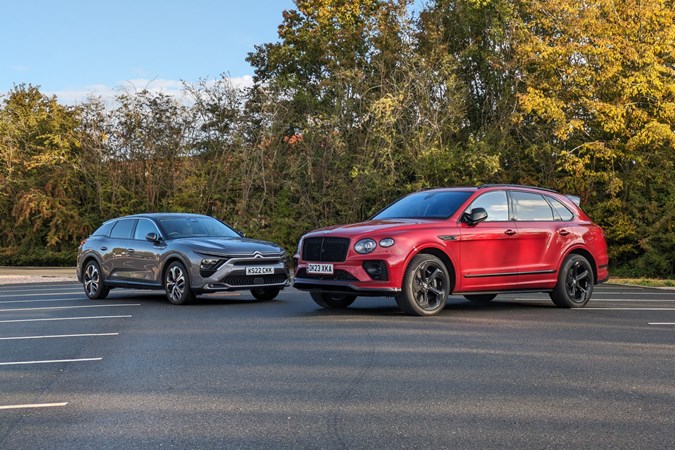
It’s a kind of car design greatest hits to make family life easier – tall enough to make getting car seats in and out easy, but with a more attractive, non-boxy silhouette. And despite all this, a massive fifth door boot lid so you can make the most of the storage space on offer.
I said before that I think I’d stick a six-cylinder diesel engine in it given the choice, but since there isn’t one, the PHEV powertrain is the next best thing. There would definitely be a practicality benefit to picking the smaller engined car but I just love the way the electric and petrol motor combine to deliver a quiet, wafty ride and useful fuel economy.
On that point, I’ve done the maths now and over my time running the C5 X my average petrol use was 49.8mpg. We went away at Christmas time and didn’t have access to a charger, which really put a dent in my figures.

For the bulk of the test, I was charging the car before every trip and getting 60mpg+ (one tank came in at 73mpg) and filling up from nearly empty every 500 miles or so, which is pretty good. This was mostly doing journeys under 50 miles though, which is right in the C5 X’s sweetspot. Later on, with some longer trips and less charging I saw 50 and 40mpg between fill ups, and finally a 34mpg tank thanks to a long motorway drive on a flat battery.
So as with anything you should have a think about what your driving requirements are before choosing which version to buy. Bear in mind my test was only over six months – if you expanded that to three years and the vast majority of my driving returned 60mpg+ (aside from the occasional long drive) I think I’d be pretty happy.
I don’t think the C5 X will make my top five long termers of all time – it didn’t stir my soul like the violent green Skoda Octavia vRS Estate or enable adventures like the VW Transporter, but it is without a doubt the most comfortable car I’ve ever spent this much time in, and that in itself is worthy of applause.
Unconventional but not to the point where it became annoying, and softly sprung without the resulting compromises in handling, it’s a really good left-field choice for a family car and one I’d certainly have no hesitation in recommending.



